Samuel Coleridge-Taylor at 150
On Coleridge-Taylor's 150th anniversary, we look at some of the material relating to the composer from our collections.
15 August 2025On Coleridge-Taylor's 150th anniversary, we look at some of the material relating to the composer from our collections.
15 August 2025Blog series Music
The British Library and the five other Legal Deposit Libraries of the UK and Ireland are embarking upon a drive to collect as many digital scores as possible from composers and independent publishers, so that our collections can better represent the enormous range of music-making happening today.
This is part of our work to collect music under the terms of the Legal Deposit Libraries Act 2003 and the subsequent Non-Print Works Regulations 2013. While we have arrangements with some major publishers to send us copies of every work they publish, the changing landscape and significant increase in self-publishing means that our current collections of contemporary music have many gaps, which we urgently want to rectify.
We want to raise awareness of the importance of Legal Deposit, and of its obligations for self-publishing composers and independent publishers.
Legal Deposit is a centuries-old mechanism that has facilitated the systematic collection and preservation of music published in Britain since the 18th century. It safeguards cultural heritage for future generations and provides a snapshot of the music-making of any given era. A large proportion of the British Library’s vast collection of printed music – from 18th century classical scores to pop sheet music of the 2000s – has been collected this way, and we rely on publishers and self-publishing composers to send us their scores to make sure the national collection continues to grow and reflect changing practices of music-making.
Under the terms of the Legal Deposit Act 2003, all publishers (including self-publishing authors and composers) are obliged to provide one copy of each of their published works, free of charge, to the British Library. ‘Published’ work includes anything made available to the public, for instance through a works list on a website where performance or perusal materials can be requested on a direct or on-demand basis.
For composers and publishers, Legal Deposit means that scores will be preserved in the long-term and available to current and future generations of musicians and researchers to consult at the Library. Library users are able to study the scores under strictly controlled, view-only conditions in our reading rooms. No downloading is permitted.
Electronic publications now fall within the remit of Legal Deposit collecting, and libraries around the world have been developing infrastructure to collect, preserve, and make available digital scores. Digital music publishing has taken off considerably in the past decade, with ever-more scores being made available in PDF and other formats. Digital scores carry a higher risk of loss associated with the precarities of fast-changing digital infrastructure. Having a copy preserved at the British Library will provide an additional safeguard for the long-term preservation of digital scores.
Composers and publishers: we need you!
We are therefore calling out to composers and small publishers to send the British Library one copy of each of their available digital scores. This should be in the format in which it is made available to the public or performers: most often, this is PDF, but we can accept music notation files and are happy to be in touch if you wish to send other formats. We also accept ‘bundles’ of material in cases where audio files are routinely made available alongside scores.
Once processed and securely preserved by the British Library, the material will be available for library users to view on dedicated computer terminals in reading rooms at the six Legal Deposit Libraries: the British Library; Bodleian Library, University of Oxford; Cambridge University Library; National Library of Scotland; National Library of Wales; and the Library of Trinity College, Dublin. Readers will be able to view files but will not be able to download them, and all normal copyright restrictions will apply.
Please help us preserve your music for future generations. Get in touch with digitalscores@bl.uk to start the process: we look forward to working with you!
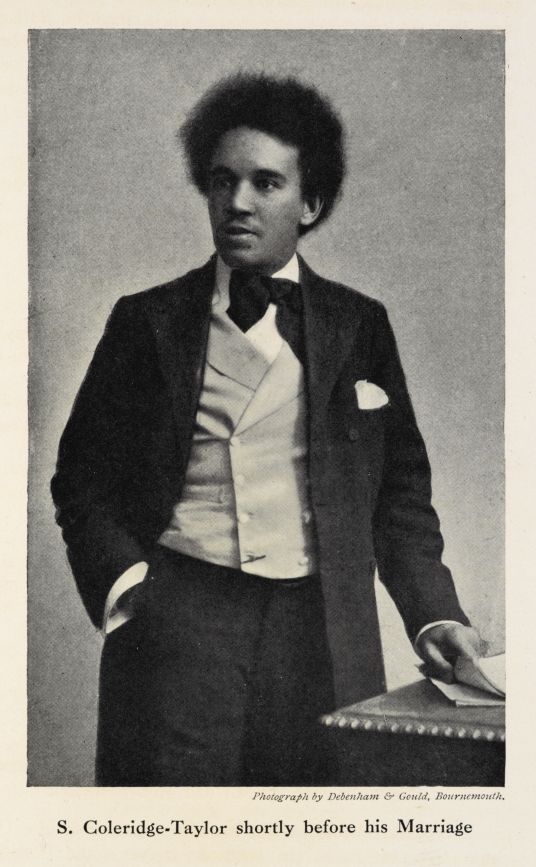
Samuel Coleridge-Taylor © Debenham & Gould, c.1899. Public Domain
As one of the most important British composers of the early 20th century, Coleridge-Taylor is represented well within the British Library’s music collections. While the single largest collection of his manuscripts can be found at the Royal College of Music, the British Library also holds a significant collection of autograph manuscripts alongside hundreds of printed scores and important early recordings of his music.
On the occasion of Coleridge-Taylor's 150th anniversary, we wanted to join in the celebrations by providing an overview of our Coleridge-Taylor materials, together with brief information about how the material came to be at the Library, and why we are still making new Coleridge-Taylor discoveries within our wider archives of 20th century music.
The British Library’s catalogue of printed sheet music lists almost 600 scores by Samuel Coleridge-Taylor. He didn’t write this many pieces: the figure includes 91 arrangements of Coleridge-Taylor’s music for other instrumental forces, around 20% of which are by the composer himself. It also includes appearances of individual pieces in compendiums for particular instruments or purposes – examples include a 1932 volume titled Music for the Home and the 2023 ABRSM Grade 8 violin syllabus – as well many reprints and later editions issued by publishers (to whom Coleridge-Taylor often handed over his copyright for low sums of money). In recent decades, there has been a gradual uptick in the number of new editions per year, including critical and scholarly editions, the creation of full performance sets for works previously tricky to perform owing to a lack of available materials, and more arrangements to make his music accessible to different instruments and ensembles. With six new Coleridge-Taylor editions added to the BL catalogue between 2021 and 2023 alone, the upwards trajectory looks set to continue as the composer’s popularity goes from strength to strength.
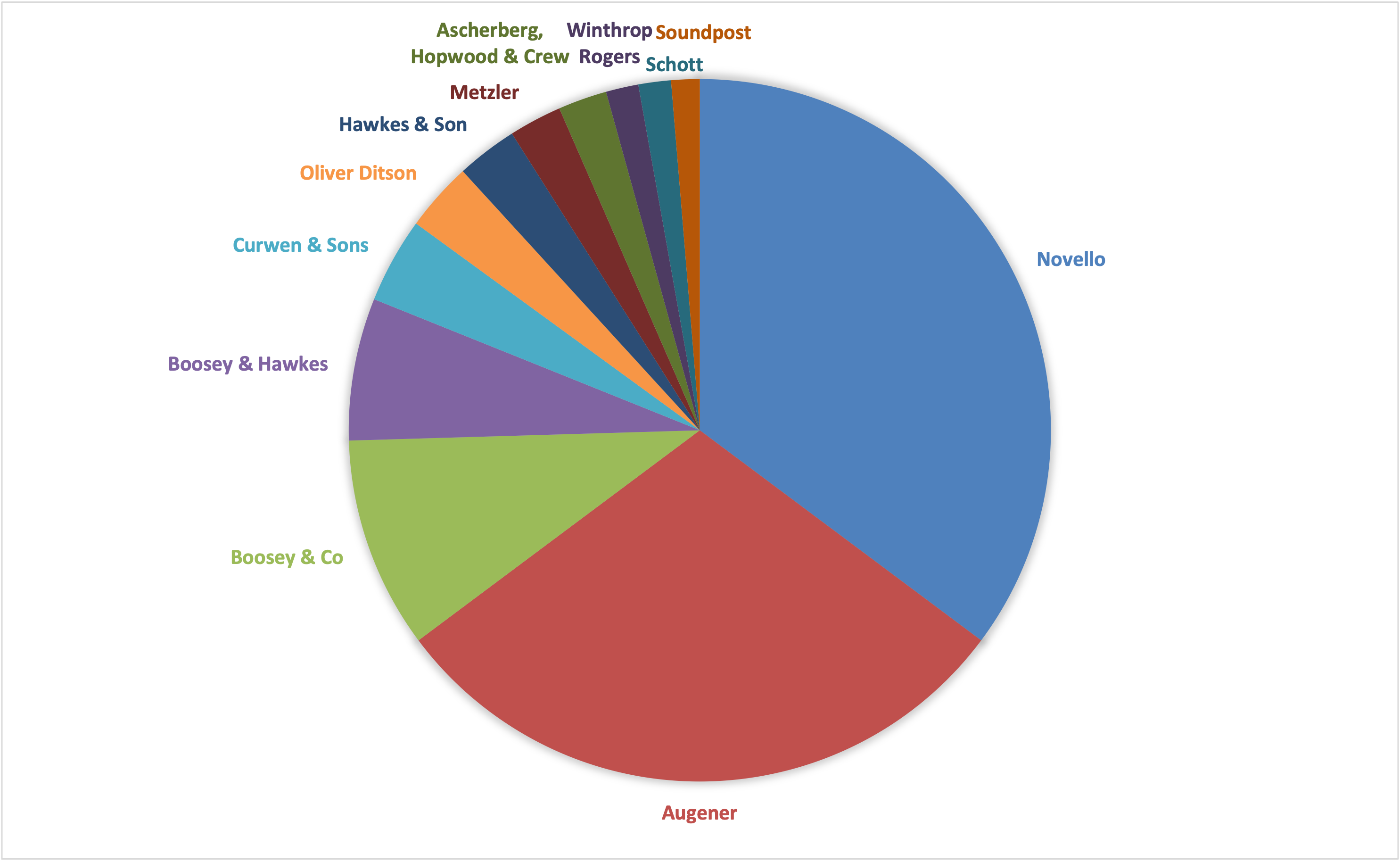
Pie chart showing the top publishers of Coleridge-Taylor’s music present in the British Library’s collection (click to view larger).
The pie chart above shows the top 12 publishers of Coleridge-Taylor scores (of 50 in total) in the Library’s collection, according to a basic export of catalogue data. The bar chart below shows the number of Coleridge-Taylor scores by year of publication (with disclaimers that the data itself is rough, and many records use approximate or inferred publication dates). The data indicates the enormous popularity and marketability of Coleridge-Taylor’s music in the 1890s, 1900s and 1910s. Following his death in 1912, the publications per year rapidly decreases – though publishers made the most of producing new editions and arrangements. The numbers decline markedly into the mid 20th century, until a resurgence of interest in Coleridge-Taylor’s music – thanks partly to the dedication of several key individuals and collectives – led to the steady upward trajectory present since the 1990s. View the titles available at the British Library (PDF, 176.4KB).
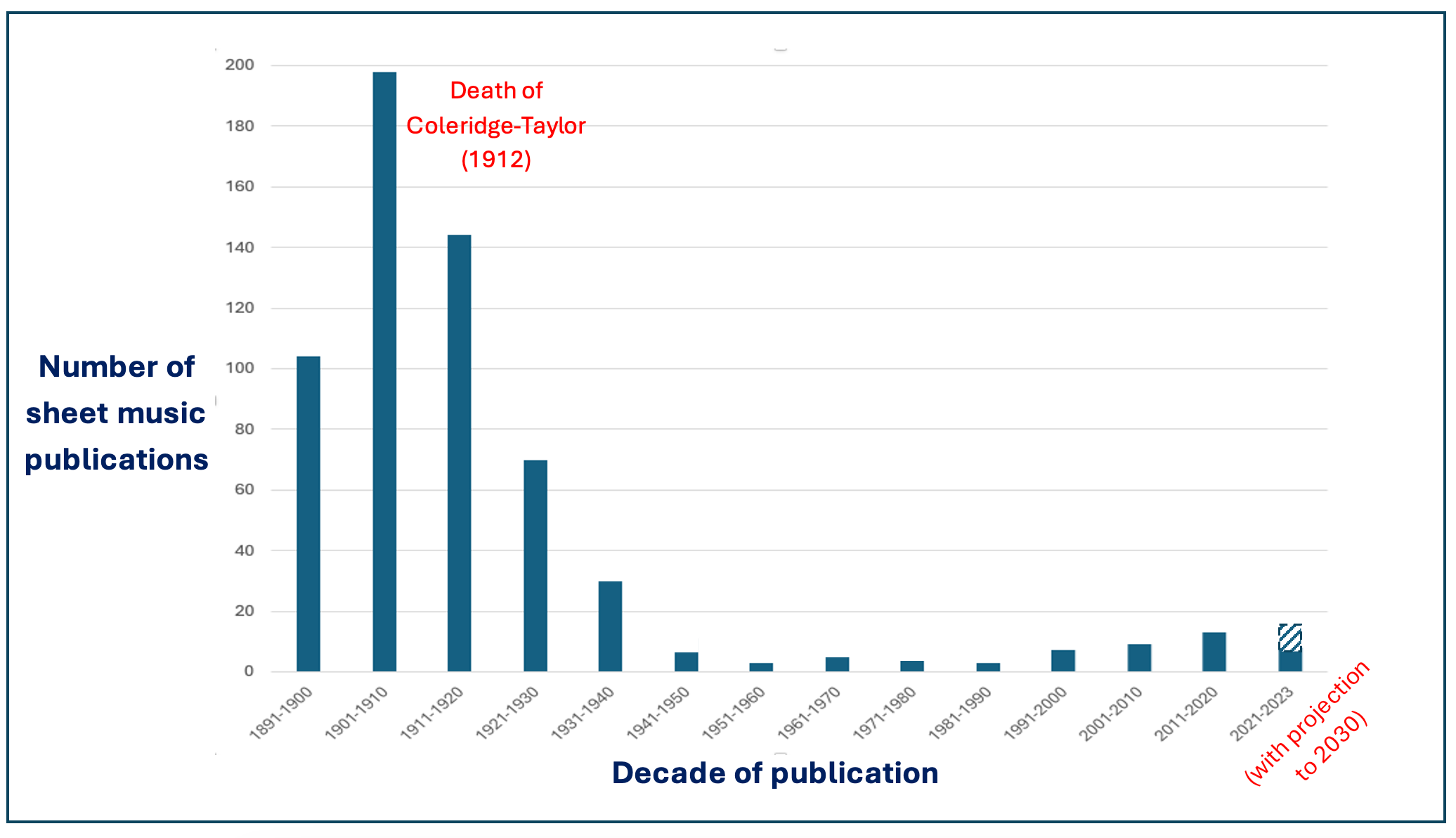
Bar chart showing indicative number of published scores per decade present in the British Library catalogue, based on a lightly-processed export of catalogue data.
A brief look at the catalogue data for sound recordings in the Library’s collections tells a similar story. Technologies for commercial recording (at first acoustic, then electric) only really took off towards the end of Coleridge-Taylor’s life, but at least a dozen recordings of his music were made before the end of the 1920s.
The Library holds important early wax cylinder and phonograph recordings of songs, instrumental pieces, and short orchestral works, which continued being made until the Second World War. The enduring popularity of the Hiawatha cantatas led to notable recordings of this landmark work in the mid-century, including a 1961 version by Malcolm Sargent with the Royal Choral Society. (Sargent and the RCS were long associated with Hiawatha, having given annual staged performances at the Royal Albert Hall from the mid-1920s up until the war). More recently, many premiere recordings have been made of Coleridge-Taylor’s chamber, orchestral, choral, and vocal music.
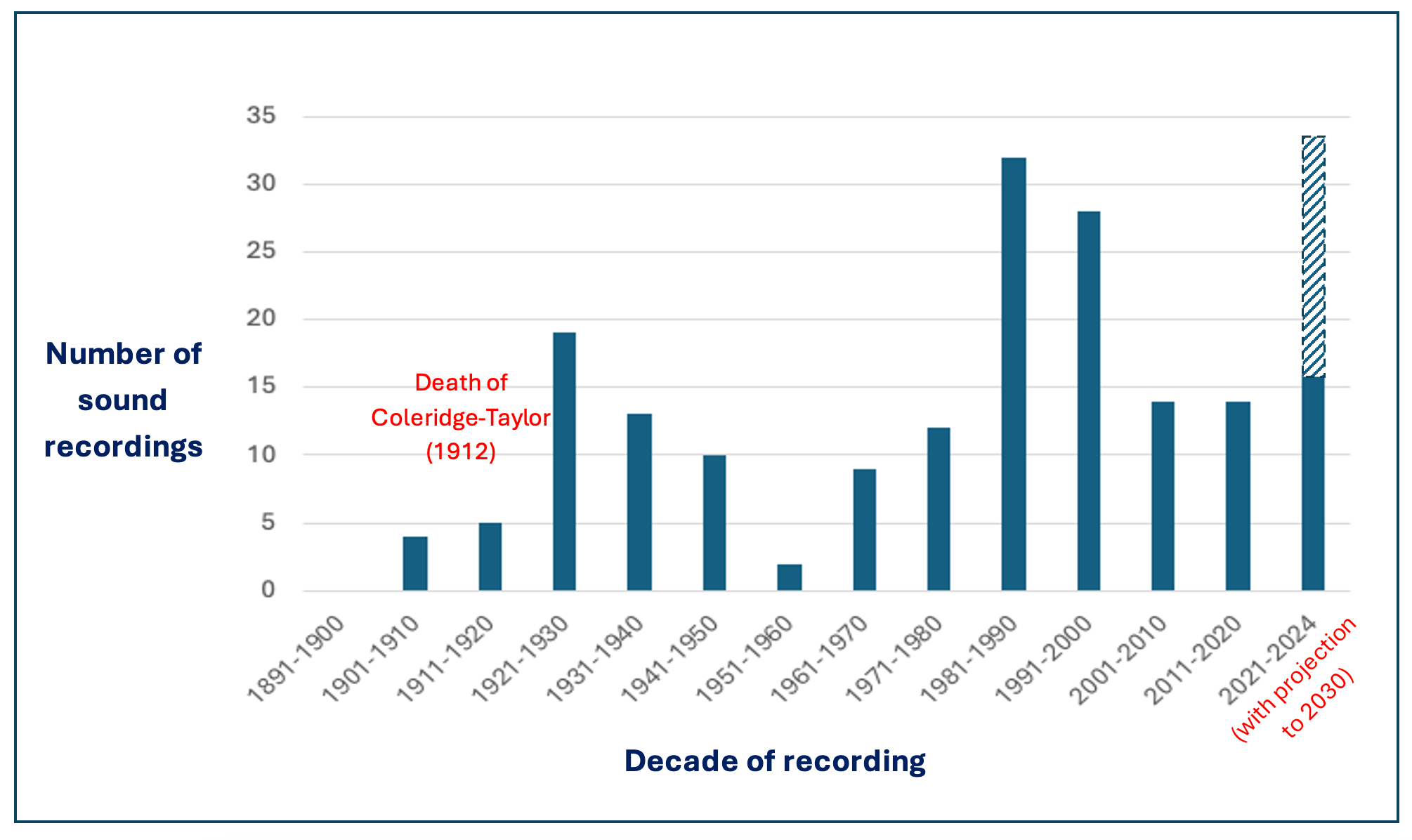
Bar chart showing indicative number of recordings per decade present in the Sound and Moving Image catalogue, based on an export of catalogue data.
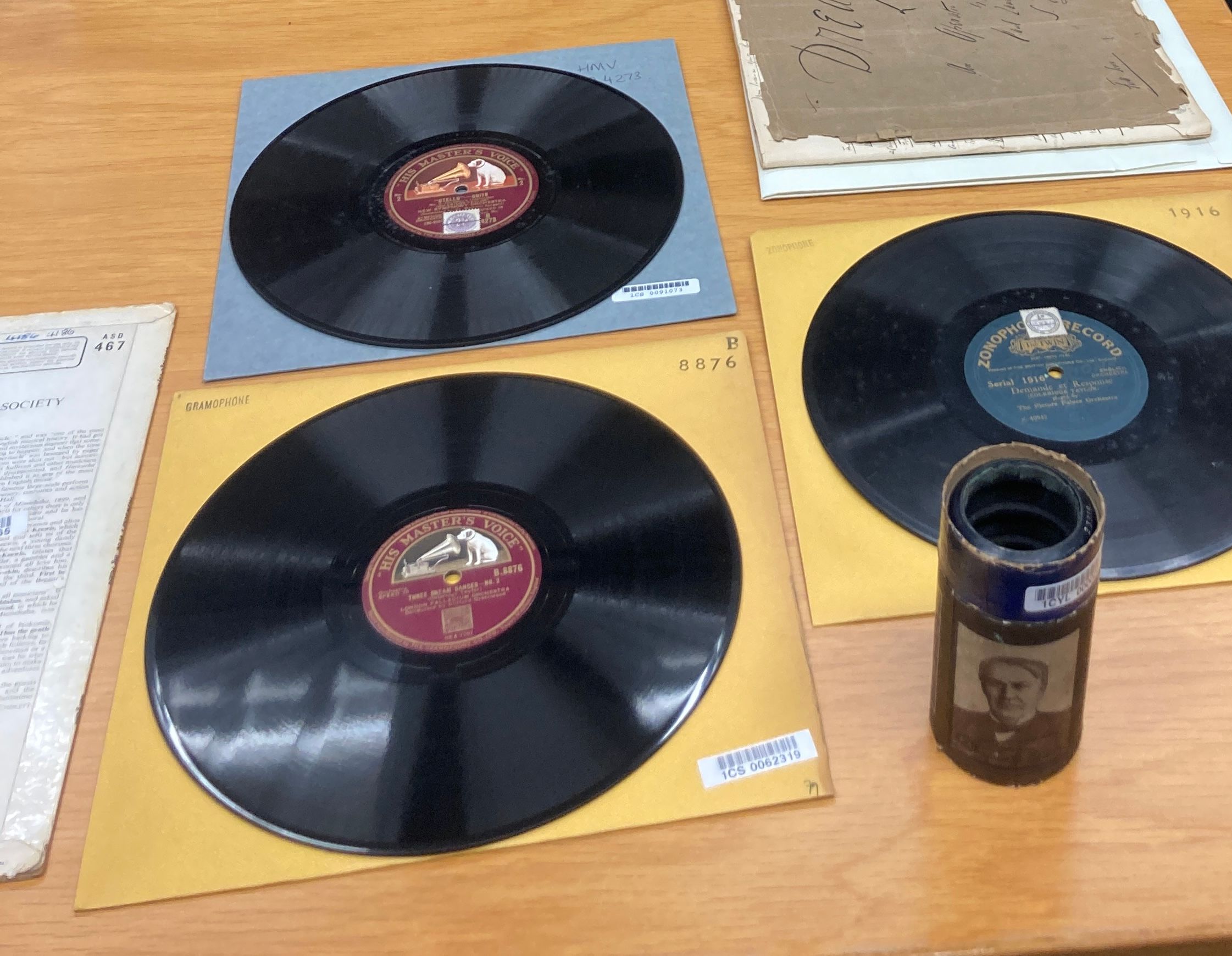
Items from the Sound Archive: 78 rpm discs and a wax cylinder.
Most of the fragile early published and unreleased recordings in the Sound & Vision collection have been digitised for preservation reasons. More recent recordings – on formats like open reel tape and cassette – pose their own preservation challenges, and many such collections were digitised as part of the Unlocking our Sound Heritage project (2017-2022). Highlights from the unpublished archival recordings digitised during the UOSH project include a 2-hour concert of Coleridge-Taylor’s music hosted by the Black Cultural Archive in 1985, and items from a concert given by Avril Coleridge-Taylor of music by father (along with her own compositions) in 1965.
The Library holds autograph manuscripts for around 55 pieces of music by Coleridge-Taylor, across 36 shelfmarks. View a list of these (PDF, 77.2KB). Highlights include autograph full scores of the Hiawatha trilogy, lesser-known cantatas including A Tale of Old Japan, and the operas Thelma (which was revived thanks to the research of Catherine Carr) and Dream Lovers. The manuscripts also include full scores of orchestral works such as the Ballade in A minor, many songs and piano pieces, Coleridge-Taylor’s own arrangements of his music.
The composer’s handwriting is beautiful and highly legible – it is clear from annotations and signs of use that many of the autograph scores, especially of larger works, had been used in performance. These autographs came to the Library via various means, some purchased from Coleridge-Taylor's descendants, others from the archives of his publishers. The Library is currently in the process of having its Coleridge-Taylor autograph manuscripts digitised, so they will be available to view online in the future. Beyond autographs, there are also some useful copy manuscripts – annotated engravers’ copies and publishers’ proofs – which shed light on the process of publication.
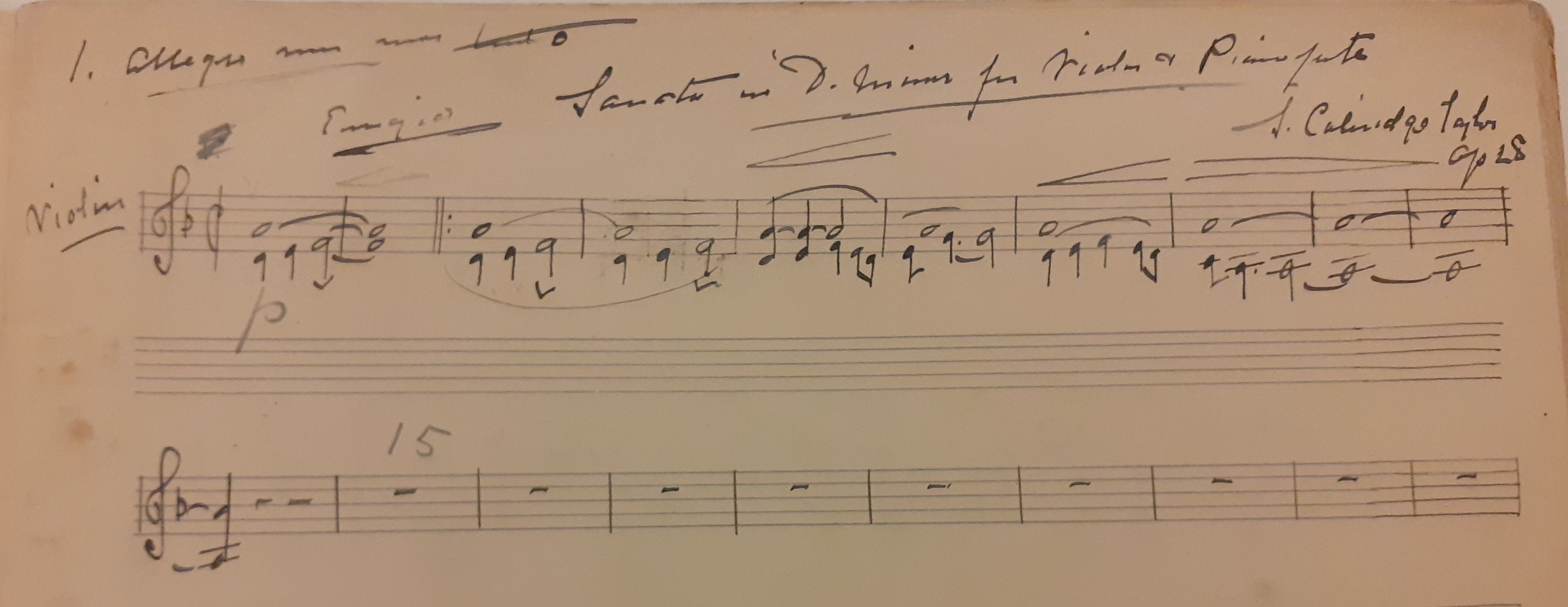
Opening of Violin Sonata in D minor, violin part. MS Mus. 1813/1/2/95/5.
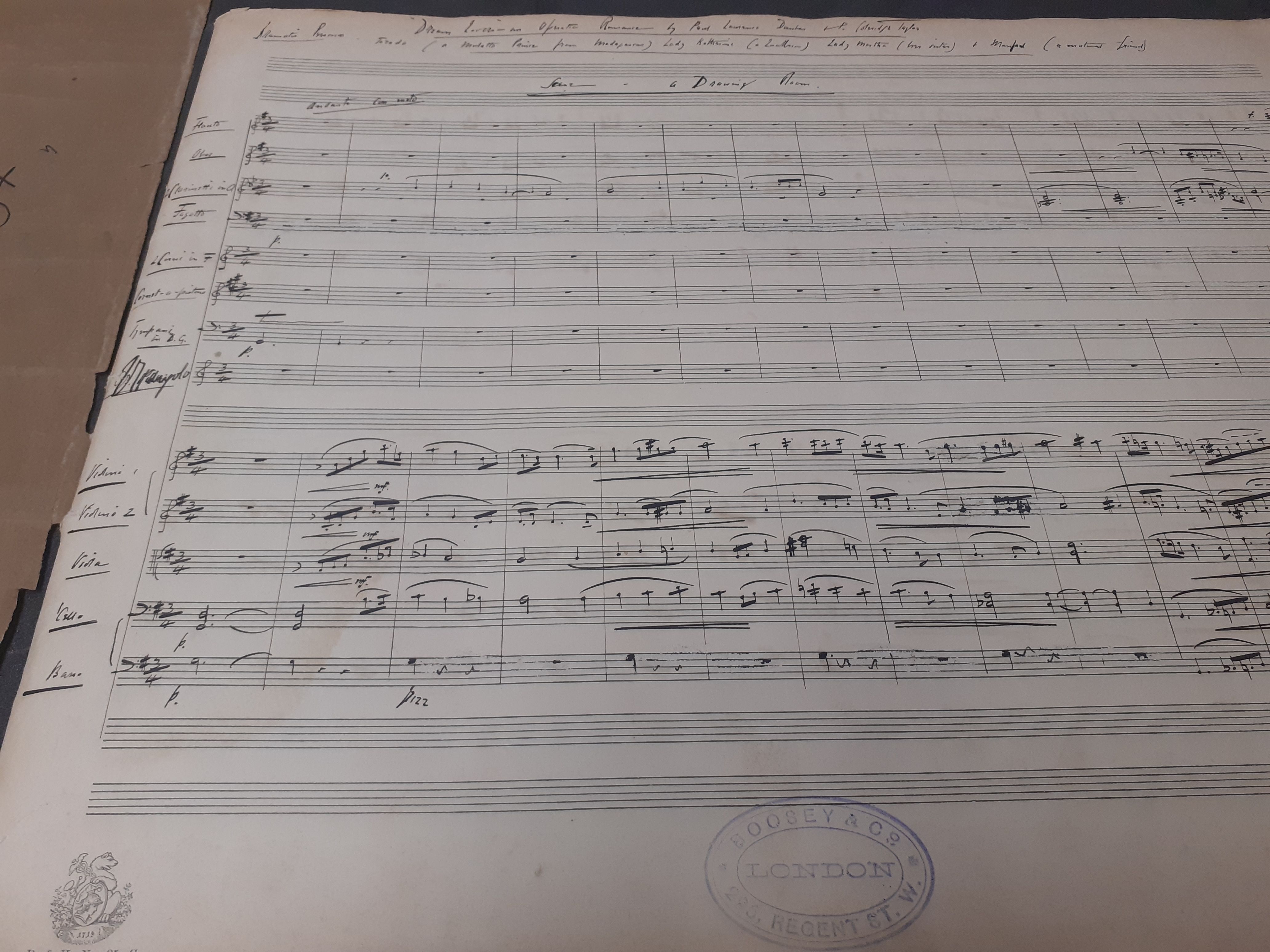
First page of autograph full scores of Dream Lovers, op. 25. MS Mus. 1813/1/[PRO7s].
A number of Coleridge-Taylor autograph manuscripts in the Library’s collections have only come to light recently, as ongoing cataloguing of the large Boosey & Hawkes archive continues to uncover material relating to the publishing company’s history and the music of the composers it represented. Coleridge-Taylor was one of those composers, and among the manuscripts used in the preparation of printed editions are autograph scores of his violin sonata in D minor, op. 28 (which was edited for posthumous publication, in 1917, by Albert Sammons), and several songs.
Of larger scale works, the archive also contains a manuscript score of the incidental music Coleridge-Taylor composed for an adaptation of Goethe’s Faust presented at His Majesty’s Theatre, Haymarket in 1908. Perhaps most excitingly, a full score of Dream Lovers, the opera he composed with the poet Paul Laurence Dunbar, has also come to light. This was published Boosey & Co. in 1898, but only issued as a vocal score. This manuscript shows us Coleridge-Taylor's intentions fully realised in orchestral form.
The archive also holds various arrangements of Samuel Coleridge-Taylor's music – one example transforms the ballet music from Hiawatha into a version to appear in the long-running Hawkes’s Military Band Journal. As mentioned before, arrangements provide clear evidence – if more were needed – of the popularity of Coleridge-Taylor's music.
The administrative papers that also form part of the archive don’t contain any correspondence with Samuel himself, but there is quite a bit from members of his family. These offer a clear picture of their tireless efforts to promote his music and to ensure it remained known. Letters from Jessie Coleridge-Taylor repeatedly remind Leslie Boosey about the need to renew copyright in the USA.
Letters between Leslie Boosey and Coleridge-Taylor's son, Hiawatha, from 1940 reveal plans to use Samuel’s music in an unnamed film, produced by the British National Films Company. Avril Coleridge-Taylor – Samuel’s daughter, herself a composer, conductor and pianist – is the best represented of the family within this archive. Her correspondence addresses aspects of her own music and makes clear her lifelong persistence in trying to encourage interest in and performances of her father’s music.
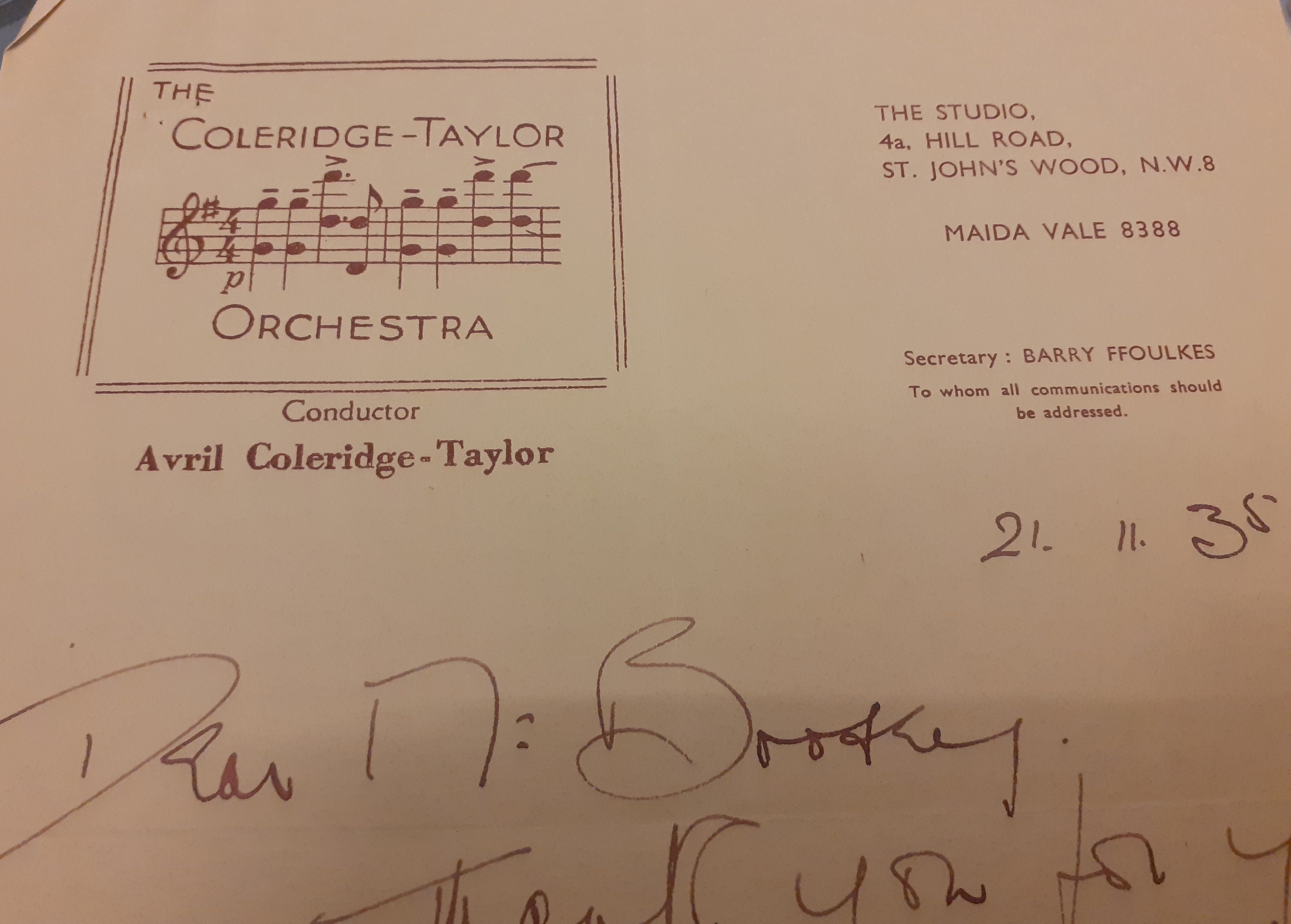
The letterhead of the Coleridge-Taylor Orchestra. The musical notation is from the opening of Hiawatha’s Wedding Feast. From a letter from Avril Coleridge-Taylor to Leslie Boosey, 21 November 1935.
Autograph manuscripts have recently come to light elsewhere, too: at the Royal College of Music, cataloguing work led to the discovery of a new song, which has since been recorded and digitised. Find out more on the Royal College of Music website.
Thanks to the work of researchers and performers over the past few decades – building upon the work of his family and earlier advocates – Samuel Coleridge-Taylor’s name has gradually been reintroduced to contemporary audiences. Archives and libraries are key resources for this type of work, and we hope to facilitate much more research into Coleridge-Taylor’s music in the future.
Royal College of Music accessions list, which lists their Coleridge-Taylor manuscripts and archive holdings.
Photographs and census documents at The National Archives.
Samuel Coleridge-Taylor Foundation website with catalogue of works compiled by Dominique-Rene de Lerma.
Electronic copy of PhD thesis on Coleridge-Taylor’s music by Catherine Carr, Vol. 2 of which provides a source list (Vol 2).

This blog is part of our series exploring the music collections of the British Library, encompassing materials in all formats – manuscript, printed and digital editions, recordings, literature – from all periods.
This blog focuses on updates and events relating to our music manuscripts and archives and our printed music collections, while updates relating to music recordings can be found in the Sound and Vision series.

You can access millions of collection items for free. Including books, newspapers, maps, sound recordings, photographs, patents and stamps.